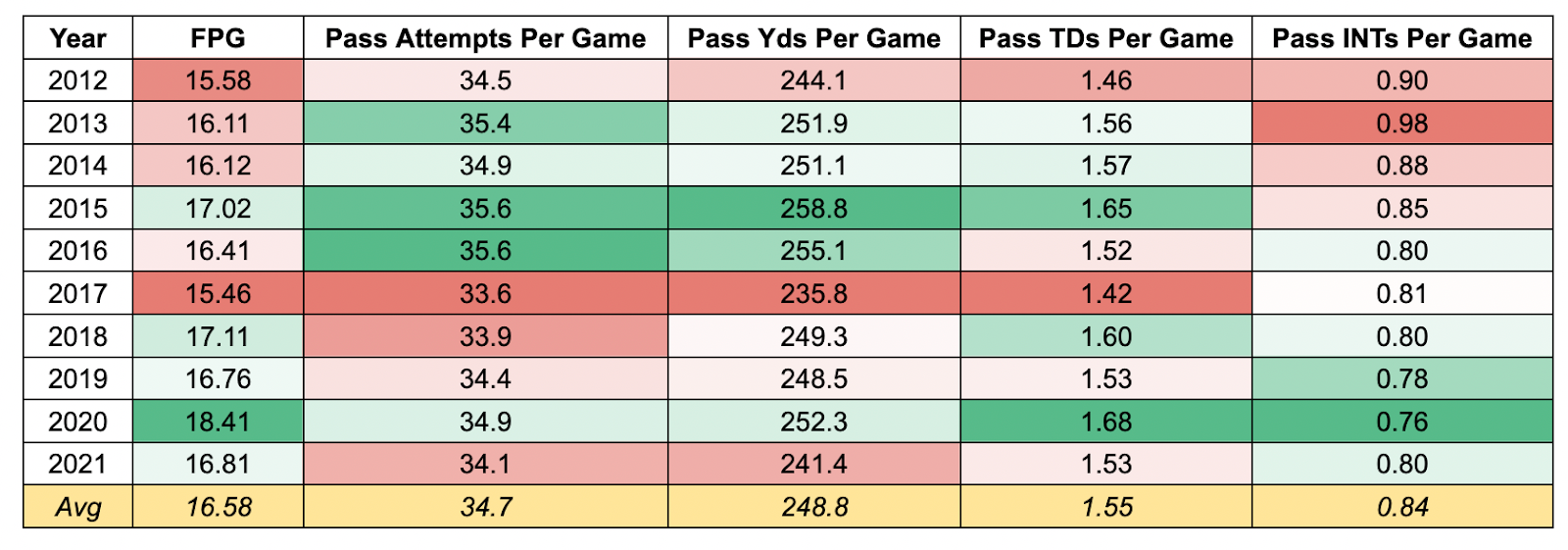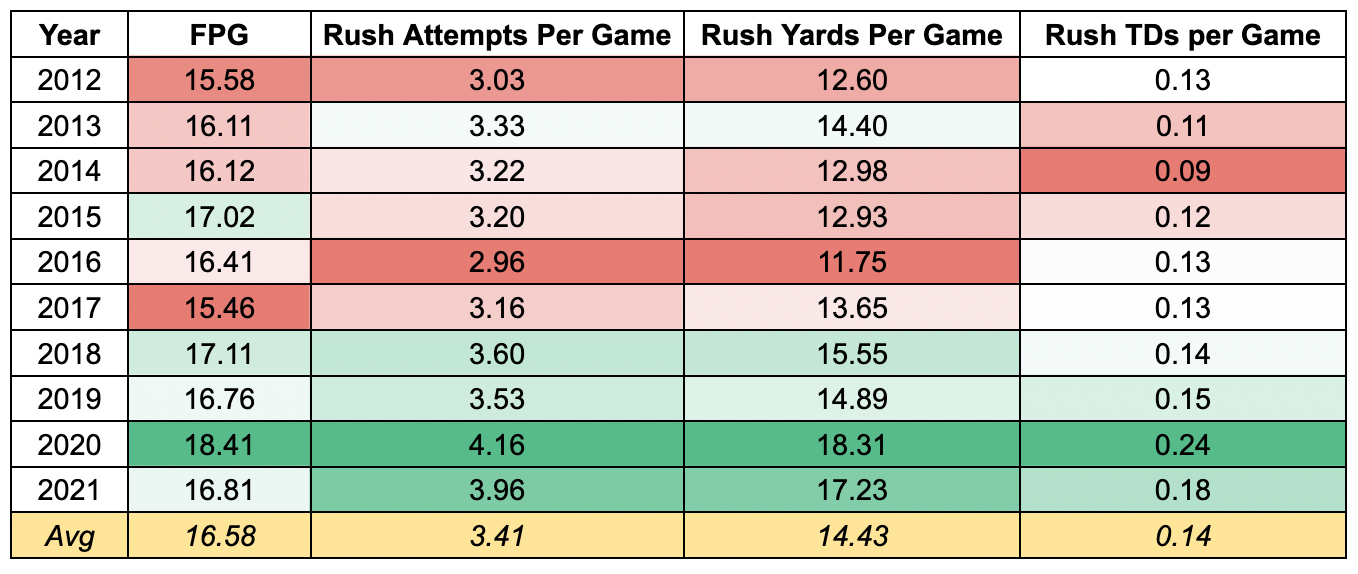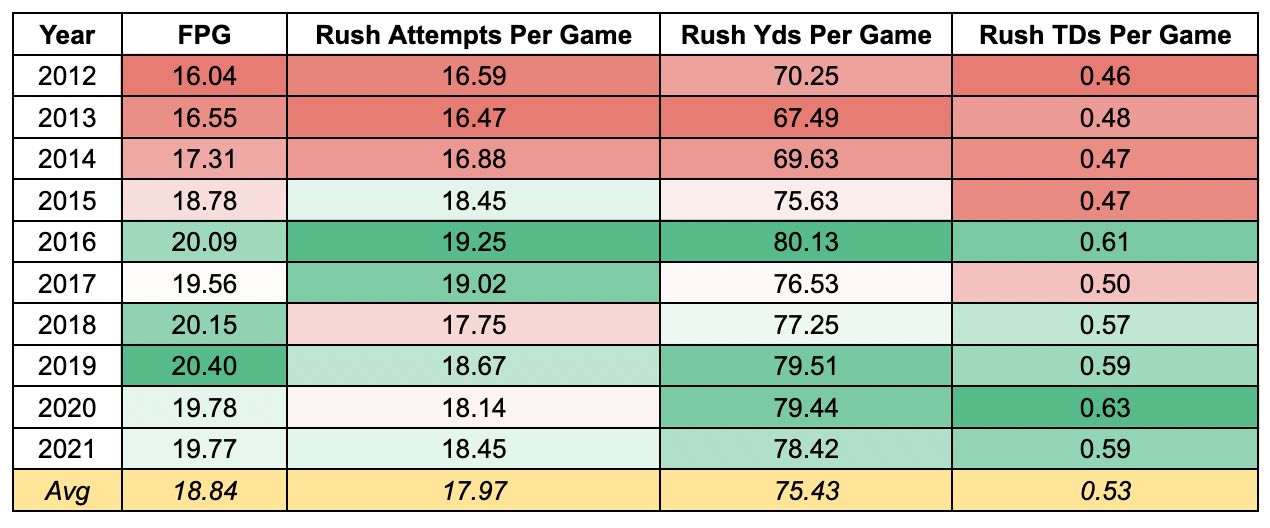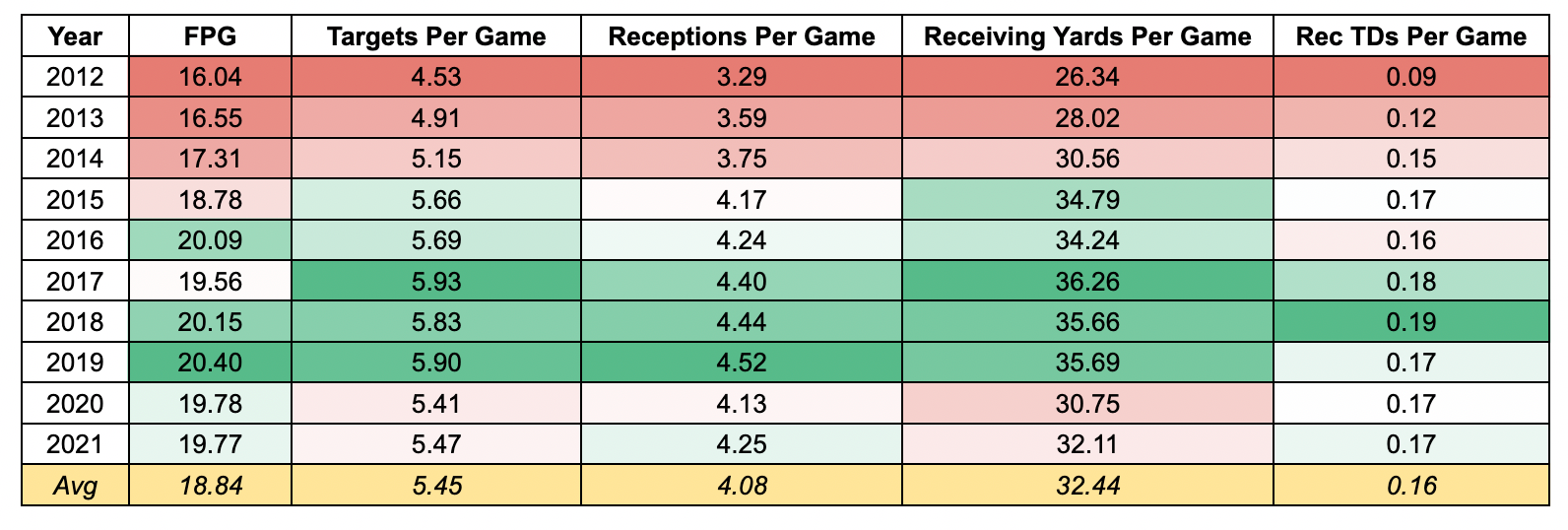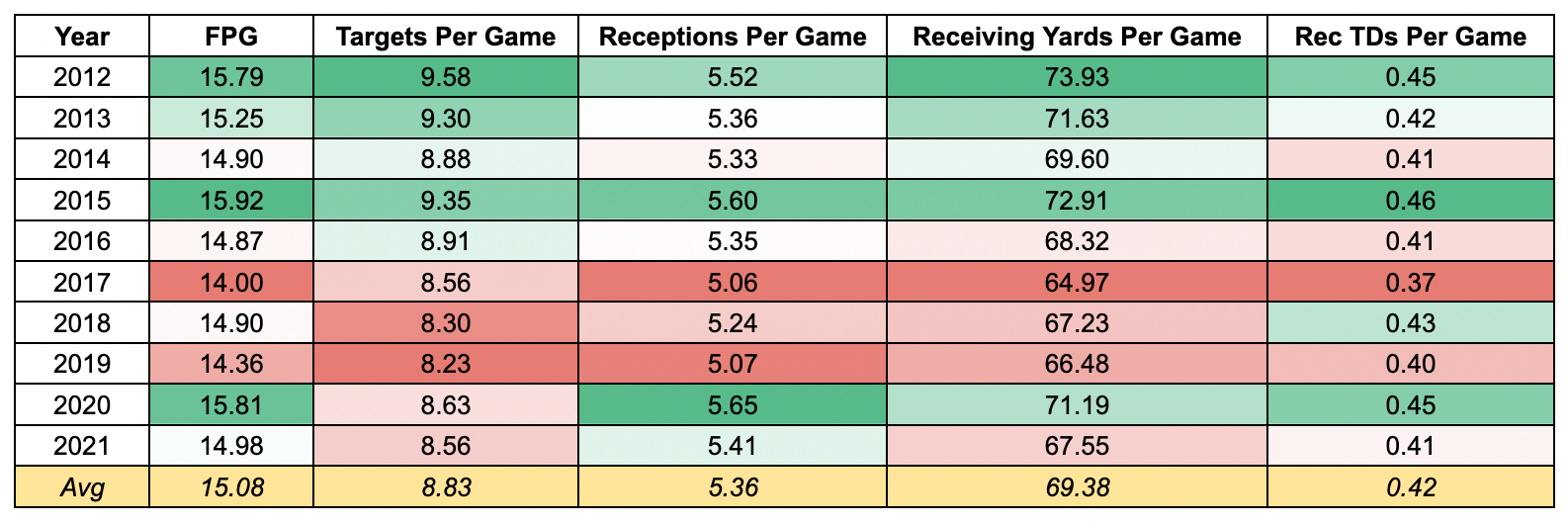Every offseason, I always like to start my research for the upcoming season with a look back at some high level fantasy trends. My job, especially during the season, is pretty granular in that I’m constantly looking for small sample signals for each game. That can get a bit repetitive after 18 weeks! So, it has been nice to have a reset over the last few weeks and start looking at 2022 things from a 1,000-foot high level view.
Let’s get it started with a look at some scoring trends for each position. It’s so easy to get wrapped up into player analysis (will JuJu Smith-Schuster bounce back in 2022 on a new team?) when some of the easy wins we can make are more constructional in nature (why did QB scoring drop off last season?).
Just note that all of the data we’re looking at are total stats from each position. If a QB started just one game in 2021, his stats count in this study. To account for the season being expanded this past year, all of the trends are on a per game basis.
Let’s get to it with a look back at the last 10 years of positional scoring…
Quarterbacks
Passing Stats
Rushing Stats
Well, the 2020 season looks like an even bigger outlier in this light.
Two years ago, we saw record highs for quarterbacks pretty much across the board with the most unique NFL season also being the highest scoring year on record.
In fact, the team scoring average in 2020 was a monster 24.8 points per game and that dipped down to a much more normal 23.0 points per game this past year. Offensive points scored per game dropped 11% year-over-year in 2021, but was directly in line with the 10-year average.
My theory on the 2020 outlier season is two-fold. Because the offseason was shortened, defenses had less time to gel than usual. Not only has there been less emphasis on padded practices with live tackling in Training Camp in recent years, all of these defenses just got fewer reps to work on communication and assignments in general.
Secondly, penalties were called more often in the offenses’ favor more often than in any recent season in history. The zebras swallowed their whistles particularly when it came to offensive holding. In 2020, we only saw 1.8 offensive holding calls per game – that figure was 2.8 holds per game in both 2018 and 2019.
In 2021, we saw holding calls tick back up (2.4 per game) but they were still called less frequently than in 2018 and 2019.
That 2020 season was also unique in that a record 1.21 defensive pass interference (DPI) calls were made per game. That represented a whopping 26% increase in DPI calls from the 10-year average.
DPI’s were called 1.1 times per game in 2021, which is a slight decrease from 2020, but is still in line with the NFL’s continued emphasis on making life easier on offense.
One major thing that didn’t change at all year-over-year with quarterback scoring is their involvement as runners. In 2021, attempts, yards, and TDs per game on the ground all continued their upward trend. Unless you’re Tom Brady or Aaron Rodgers, non-mobile quarterbacks face a huge uphill battle to post top-10 seasons at the position these days.
With high school and college teams making an even larger emphasis to involve their quarterbacks in the run game and doing away with the old “pocket QB” mantra, this rushing revolution is here to stay.
Running Backs
Rushing Stats
Receiving Stats
After a very rough start to the 2010’s, running back scoring has exploded in recent years thanks to a massive talent infusion at the position. One of the main reasons the Zero RB strategy grew in popularity in 2015-17 was because of the way running back scoring was trending – but that has been unequivocally reversed in recent seasons.
The position’s peak age just continues to get younger and younger as the last several draft classes have revitalized running backs in fantasy, with the 2017 crop (McCaffrey, Mixon, Kamara, Cook, Fournette, Jones, Ekeler) being the main culprits.
Once again, we had a rookie running back finish top-10 in fantasy points per game in 2021 with Najee Harris (RB8). This marked the seventh time in the last five seasons in which a rookie runner was top-10 at the position.
Wide Receivers
With quarterback scoring normalizing year-over-year, so too did wide receiver output. No surprise.
One interesting trend that you’ll notice in the chart above is that wide receivers’ targets per game have trended down about 9% over the last five seasons compared to the previous five. Some of the downtick in volume for wideouts has gone to running backs – but there is a larger structural change going on in NFL offenses right now.
If you look back at 2012, you’ll see 14 different wide receivers got at least 25% of their team’s targets that season.
In 2020, the number of receivers that got at least one quarter of their team’s target shrunk to just eight players.
In 2021, a total of 11 wide receivers got at least 25% of the targets but just two (Kupp and Adams) saw over 30% of their team’s targets. Back in 2012, a total of six receivers were funneled a 30% target share.
In general, we’re seeing NFL offenses become less condensed – which makes the pool of wide receivers a bit deeper and makes their scoring even more variable.
Tight Ends
Well, tight end still sucks!
The middle class of tight ends has completely eroded away in recent years and we’re now down to three (maybe four) elite options at the position surrounded by a bunch of streamer-types. If you don’t have Kelce, Andrews, or Kittle, you’re playing a game where you just chase touchdowns at tight end. That is much easier said than done.
Final Thoughts / Look Ahead at 2022
Offensive points per game normalized in 2021 compared to 2020, falling back in line with the 10-year trend.
Quarterback fantasy scoring also normalized year-over-year.
I think we’ll see an overcorrection in the QB market in 2022 with the public placing too big of an emphasis on 2021 being a “lower” scoring year than 2020.
A massive talent infusion at running back has driven a huge resurgence in scoring at the position with the 2017 class fueling the bulk of it.
In general, we’re seeing NFL offenses become less condensed – which makes the pool of wide receivers a bit deeper and makes their scoring even more variable.
The middle class of tight ends has completely eroded away in recent years. With Travis Kelce aging and Rob Gronkowski potentially re-retiring, we desperately need a youth infusion just like at running back. Save us, TJ Hockenson and Kyle Pitts.


